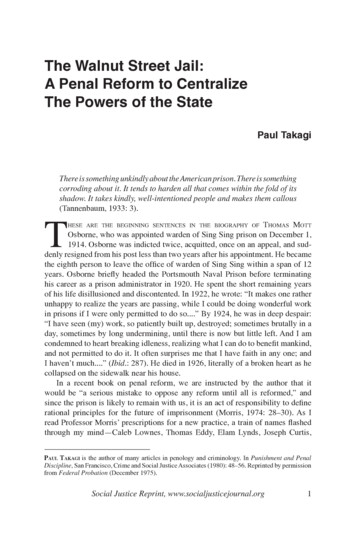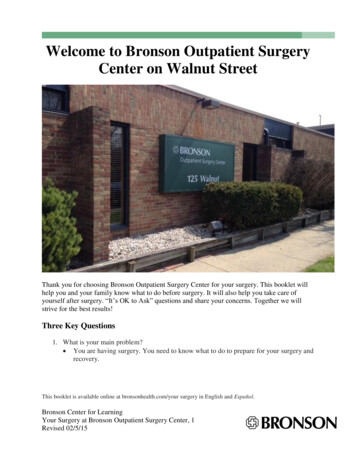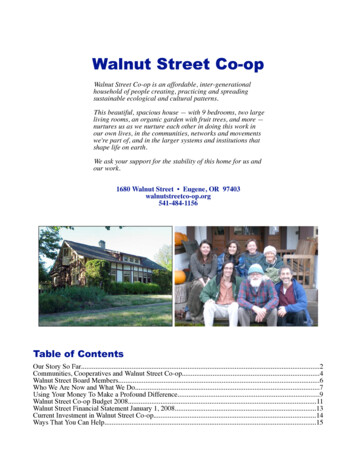
Transcription
The Walnut Street JailThe Walnut Street Jail:A Penal Reform to CentralizeThe Powers of the StatePaul TakagiThere is something unkindly about the American prison. There is somethingcorroding about it. It tends to harden all that comes within the fold of itsshadow. It takes kindly, well-intentioned people and makes them callous(Tannenbaum, 1933: 3).TThomas MottOsborne, who was appointed warden of Sing Sing prison on December 1,1914. Osborne was indicted twice, acquitted, once on an appeal, and suddenly resigned from his post less than two years after his appointment. He becamethe eighth person to leave the office of warden of Sing Sing within a span of 12years. Osborne briefly headed the Portsmouth Naval Prison before terminatinghis career as a prison administrator in 1920. He spent the short remaining yearsof his life disillusioned and discontented. In 1922, he wrote: “It makes one ratherunhappy to realize the years are passing, while I could be doing wonderful workin prisons if I were only permitted to do so.” By 1924, he was in deep despair:“I have seen (my) work, so patiently built up, destroyed; sometimes brutally in aday, sometimes by long undermining, until there is now but little left. And I amcondemned to heart breaking idleness, realizing what I can do to benefit mankind,and not permitted to do it. It often surprises me that I have faith in any one; andI haven’t much.” (Ibid.: 287). He died in 1926, literally of a broken heart as hecollapsed on the sidewalk near his house.In a recent book on penal reform, we are instructed by the author that itwould be “a serious mistake to oppose any reform until all is reformed,” andsince the prison is likely to remain with us, it is an act of responsibility to definerational principles for the future of imprisonment (Morris, 1974: 28–30). As Iread Professor Morris’ prescriptions for a new practice, a train of names flashedthrough my mind—Caleb Lownes, Thomas Eddy, Elam Lynds, Joseph Curtis,hese are the beginning sentences in the biography ofPaul Takagi is the author of many articles in penology and criminology. In Punishment and PenalDiscipline, San Francisco, Crime and Social Justice Associates (1980): 48–56. Reprinted by permissionfrom Federal Probation (December 1975).Social Justice Reprint, www.socialjusticejournal.org
TakagiThomas Mott Osborne—each, well-intentioned with ideas about reforming theAmerican prison, in the end quit, bitter and disillusioned, or, if they remained on,instituted more brutal and repressive measures.Liberal reformers have characteristically viewed the prison as a self-containedentity, believing that the conflicts and contradictions within it could be solvedthrough reasoned intervention. The futility of the approach is not only evidencedby history, but the explanation of their failures has had the effect of prolongingtheir fruitless efforts. Political interference, inadequate budget, overcrowding, poorphysical plant, and more recently, radical agitators both inside and out, have beenthe usual explanations; and if these explanations do not apply, some mysteriousqualities are attributed to the prison.The penal reforms of the past as well as those that are being proposed todaydo not make any sense without a precise analysis of that which is being reformed.To put it differently, if we understand the prison to be an apparatus of the statedesigned as a repressive institution, then we need to understand how and why thiscame about. This is crucial because the prison as an entity (and the problems associated with it) are the effects, resulting from changes in the larger society. Forexample, the increased number of black prisoners since the end of World War II isdirectly related to the techno-economic changes that have occurred, creating whateconomists call technological unemployment, or a surplus labor force. Young blackmales have been especially hard hit, suffering an unemployment rate of 40 to 50%ever since the end of World War II, and the expansion in prison construction duringthe corresponding period provides a clue on the role of the state with respect tomodifications in productive relations.Perhaps one reason reformers have narrowly focused on the prison as if itexists in a social and political vacuum is because of the belief system on theorigins of the American prison. That is to say, most of us have been led to believethat the “gentle and humane” Quakers founded the prison as an alternative to thesanguinary English laws then in effect, and that the idea of a prison was basedupon the prevailing theory of humane reason. There are problems with theseinterpretations. Thorsten Sellin (1970) and more recently Smith and Fried (1974)have shown how the prison was not an American invention. Sellin went so far asto conclude: “The philosophy of the jail system was a British importation and the‘penitentiary house’ of the Walnut Street Jail was no innovation. English reformersgave us both the fundamental ideas and their application in practice to such anextent that no Pennsylvanian can lay claim to be inventors of the ‘PennsylvaniaSystem’” (1970: 14).Sellin collected data to show how the ideas introduced in the Walnut StreetJail were already in operation in the reformed English jails, but he did not offer anexplanation on why the Pennsylvanians adopted the system. Smith and Fried, ina brief chapter, argue that the prison reform was a product of “changing productive relationships that in turn required new justifications of both the state and the
The Walnut Street Jaillaw” (1974: 4). They suggest that the argument of humanitarian principles wasinvoked to legitimize the political basis for a new social order, and that the prisonwas designed to moderate the social conflicts resulting from the ascendancy ofthe bourgeoisie.Thorsten Sellin in his book, Pioneering in Criminology (1944), invoked a similarargument to explain the emergence of the rasp house in mid-16th century Europe.The modifications that occurred in class relations, that is to say, the breakdownof feudalism and the rise of mercantilism and the change in the nature of laborrelations, caused considerable dislocation among the workers, begging, wandering, idleness, and petty thievery, which led to the establishment of workhouses for“sturdy beggars” (pp. 9–22). The formulation by Sellin and by Smith and Friedis the point of origin for this article, to sketch out how and why the Walnut StreetJail became a prison.The Early Jail and WorkhouseThe first prison society, called the Philadelphia Society for Assisting DistressedPrisoners, was formed in 1776 following the work of Richard Wistar, a memberof the Society of Friends, and is generally believed to be the parent organizationof the Philadelphia Society for Alleviating the Miseries of Public Prisons, creditedwith the penal reforms introduced in the Walnut Street Jail. The first society apparently gathered food and clothing for the convicts and its activities centered aboutimproving the physical comforts of the prisoners. When the British army enteredthe city of Philadelphia in September 1777, the organization was disbanded. During its brief existence there is no evidence to indicate that it effected any changesin the several jails, including the Walnut Street facility.The work of Richard Wistar was apparently with prisoners lodged in the colonialworkhouses (or houses of corrections). Although jails, designed for criminals, existedas early as 1635, their use as punishment was chosen relatively less often than finesor whippings for two reasons: the jails were small and could hold but a few at onetime, and the cost of maintenance was a burden the colonial people wished to avoid(Powers, 1966: 234). It seems that colonial authorities were much more concernedwith the discipline of laborers, servants, debtors, and political prisoners, housed inworkhouses, which made its appearance sometime around 1655.Jail sentences were short and most sentences were indefinite. One might besentenced, for example, “for a time,” or “during the pleasure of the Court,” or “tillSaturday morning next,” or “until the last day of the week at night.” If a criminalsentence of a servant such as to “years of imprisonment” proved to be prejudicialto his master, the court frequently modified the sentence and released the offender(Ibid.: 234–236). A servant in colonial America was not only one who gave personalhousehold services, but was bonded to perform agricultural labor and other workfor manorial lords, merchants, shippers, and plantation owners.The workhouses began to appear with the establishment of a landed aristocracy,
Takagithe plantation owners in Virginia, the manorial lords in New York, and the merchantclass and shippers in Massachusetts. The triangular trade of “rum, molasses, andslaves” transformed the industrial base, and one of the first signs of this was theadoption of a “money economy.” In 1652, the Massachusetts colony established amint to coin the Pine Tree Shillings. The change to a money economy marked thebeginnings of a wage-working class; the wages were fixed by law and the socialposition of laborers carefully defined (Simons, 1913: 39–40). These laws wereelaborated to form a permanent class of practically hereditary working people.In all the colonies laws were passed for the imprisonment of debtors. Theselaws were not directed at the poor, but applied to wage laborers, the purpose ofwhich was to create a constant supply of subservient workers. Falling in debtbecause of misfortune or because of the extortions of landlord and tradesman, theworker was summarily dispatched to the workhouse and remained there until theimprisoned worker agreed to pledge oneself in servitude to the creditor (Myers,1925: 64–65). In Pennsylvania, the laws provided the landlords the right to recoverdebts by seizure of the imprisoned debtor’s goods and chattels; the laws heapedfurther abuse upon the worker by authorizing the jailer to be a creditor to collecthis “fees” (Ibid.: 65).Originally, the workhouse was a separate facility constructed next to the jail,but as time went on imprisonment came to be increasingly reserved for the poor.William Penn’s Great Laws attempted to fuse the original distinction between thejail and the workhouse. It declared: “All prisons shall be workhouses for felons,vagrants, and loose, abusive and idle persons (cited in Barnes, 1968: 56). Butwhen the English laws were reinstituted in 1718, they substituted for the imprisonment of criminals, restitution, fines and corporal punishment, and “where theoffender proved not of ability to make such satisfaction then he should be kept inprison or a house of correction at hard labor.” (cited in Ibid.: 60). The distinctionbetween a jail and workhouse became increasingly blurred, although the conceptof a workhouse was retained under different names. In New York, they were calledpoorhouses for “vagabonds, beggars, idle persons, and those without manual crafts”(Myers, 1925: 61), while Pennsylvania in 1766 authorized the establishment of ahouse of employment for “rogues, vagabonds and other idle and dissolute persons”(Ibid.: 60–61).1The Walnut Street Jail, which concerns us here, was authorized by the act ofFebruary 26, 1773, to replace the High Street jail constructed shortly after theEnglish laws of 1718 went into effect. The High Street jail consisted of two buildings, one for criminals, and the other for debtors, runaway apprentices, and theidle poor. The new Walnut Street facility was to be a “gaol, workhouse, and houseof correction in the City of Philadelphia” (cited in Ibid.: 62). The new jail beganto receive prisoners in January of 1776, and some 105 prisoners were moved totheir new quarters from the old High Street facility. About the middle of the year,the prisoners were returned to the High Street jail, the new prison having been
The Walnut Street Jail requisitioned by the Continental Army for the confinement of captured enemies. Itserved as a military prison until 1784, including the period when the British armyused it for the same purpose (Sellin, 1953: 326).It would appear then that Richard Wistar and the Society of Friends in organizing the first prison society on February 7, 1776, worked in the Walnut Street Jailfor only a brief period. Their main work was in the High Street facility, where thepillory and the whipping post were used as punishment for the criminals, whileimprisonment was the mode of punishment in the workhouse.The SocietyShortly after the end of the Revolutionary War, Benjamin Franklin, BenjaminRush, William Bradford, and Caleb Lownes, led a movement to reform the Englishcriminal code of 1718, which was still in effect. The new laws of September 15,1786, called for the penalty of “hard labor, publicly and disgracefully imposed”(Barnes, 1968: 81; Lewis, 1967: 16–17). This meant that prisoners would be employed in “cleaning the streets of the city and repairing the roads” and authoritieswere “to shave the heads of the prisoners, and to distinguish them by infamousdress.and to encumber them with iron collars and chains, to which bomb shellswould be attached.” (R. Vaux, cited in Barnes, 1968: 86).The Philadelphia Society for Alleviating the Miseries of Public Prisons (hereafterreferred to as the Society) was formed shortly after the new laws went into effect.Significantly, the Society’s first campaign, aside from introducing religious servicesin the Walnut Street Jail, was to amend the law. In January of 1788, the Societyprepared a report noting “that the good ends thereby intended, have hereto beenfully answered ” and recommended that “punishment by more private or evensolitary labor, would more successfully tend to reclaim the unhappy objects.”(Vaux, cited in Barnes: 86–87). In the widely cited passage from Robert Vaux’sNotices, the justification for the law change was that public punishment “begotin the minds of the criminals and those who witnessed them, disrespect for thelaws.” (cited in Barnes: 86; also Lewis, 1967: 18).Why did powerful men like Benjamin Franklin and Benjamin Rush, signersof the Declaration of Independence, and William Bradford, later appointed to theSupreme Bench of Pennsylvania, call for a change in punishment to “hard labor,publicly and disgracefully imposed,” and then change their minds within one yearto “punishment by more private or even solitary labor”? Existing works on thehistory of American penology generally assume that the Society was identicalwith the Society of Friends and conclude that Quaker beliefs were instrumentalin early penal reform. As a matter of fact, no more than 136 out of 340 membersfrom 1787 to 1830 were affiliated with the Society of Friends, and the presidentof the Society during the first 49 years of its existence was William White, Bishopof the Protestant Episcopal Church of Philadelphia (Barnes, 1968: 84). This doesnot mean that the ideas of William Penn and the Quakers in the 1780s did not have
Takagisome influence on the penal reforms, but it is important to note that when actualchanges were introduced in the Walnut Street Jail, the Society was dominated byEpiscopalians.The work of the Society, as contrasted to Richard Wistar’s earlier efforts, hadnothing to do with alleviating the miseries of the prisoners. Instead, they workedclosely with some members of the legislature, lobbying or issuing propagandamaterial, while the powerful remained in the background by not signing any of theSociety’s position papers. They nevertheless followed closely the activities of theSociety, if not actually directing them. Benjamin Franklin then was the presidentof the Supreme Executive Council (the chief executive officer) of Pennsylvaniaand signed the message to the legislature containing the recommendations of theSociety. This would suggest that during the early years of the Society’s operations,it functioned pretty much like the modern presidential commissions on crime.The 37 charter members were prominent citizens of the community representingthe major religious faiths, medicine, law, and commerce, and served to legitimizethe idea of a state prison, which meant the creation of a state apparatus. To put itdifferently, the transformation that was to occur had implications far beyond thematter of penal reform. The political process toward creating a state prison systemreflected in miniature the problems of the Confederation in centralizing the powersof the state. The demand for a strong centralized government was to guarantee thedevelopment of a new economic order on the one hand, and on the other, to solvethe problem of law and order.Revolutionary TimesThe American Revolutionary War was not based upon mass popular supportfor national independence, and like most wars, it was fought by those who had theleast interest in its outcome. For some members of the working class, conscious oftheir oppression, there was a sense of revolt, but it was a revolt against the tyrannyof the manorial lords, the system of servitude, and the repressiveness of the laws.At times, it had broken out into uprisings, but they were quickly put down, and theleaders imprisoned or executed.The war was supported by the merchant class and to get recruits, bountieswere held out as inducements. In some instances paper money as high as 750to 1,000 was paid out, and in others, land grants were offered. It is reported that“muscle men” were hired to terrorize and coerce the unwilling to volunteer (Myers,1925: 73–134; Simons, 1913: 70–80). Pennsylvania adopted a Bill of Rights toinspire the masses and to win their support for the war. Clause I of this documentasserted: “That all men are born equally free and independent, and have certainnatural, inherent and inalienable rights, amongst which are.life and liberty, (andthe) acquiring, possessing and protecting property.” In different ways the othercolonies asserted the same principles.In 1776, the ruling elites were all for paper money, restriction of the power
The Walnut Street Jail of the courts, natural rights, and the string of democratic principles espoused topromote the war. By 1786, they had rejected all of these principles.As Louis Hacker (1970) puts it: “It was one thing to obtain peace abroad; itwas another to assure the success of the Revolution at home.” The years 1781to 1789 were a critical period as the fledgling government was near collapse. Itwas the Constitution and the establishment of a strong central government thatprovided the political means for survival, stability, and future growth (Ibid.: 45).Up until then, the governing document was the Article of Confederation (a leagueof friendship among sovereign states), but it did not provide for a chief executive,a judiciary, or a taxing system to support and develop a central authority; it hadno control over the money supply, it could not regulate domestic or interstatecommerce, and it could not protect private property (Ibid.: 45–46).The condition of the Confederation’s finances had gone from bad to worse. Itwas aggravated by the arrears in unpaid interest, which had increased from 1784to 1789 by about eight and one-half million dollars in the case of domestic debtsand by nearly one and one-half million dollars in the case of foreign debts. TheContinental currency, with which the government had paid for supplies and tosoldiers, had become valueless, but new bills of credit (paper money) were issuedin an attempt to add to the money supply. The financial crisis had a profound effectupon the working class.The farmers experienced unusual distress. The crops had been good, and in manyplaces the yield had been great. “Yet the farmer murmured, and not without cause,that their wheat and their corn were of no more use to them than so many bushelsof stone. That when they wanted clothes for their family, they were compelled torun from village to village to find a cobbler who would take wheat for shoes, anda trader who would give everlasting in exchange for pumpkins. Money becamescarcer and scarcer every week. In the great towns the lack of it was severely felt”(McMaster, cited in Brooks, 1903: 74).McMaster says of New Hampshire: “It was then the fashion, as indeed it waseverywhere, to lock men up in jail the moment they were so unfortunate as to owetheir fellows a six-pence or shilling. Had this law been rigorously executed in theautumn of 1785, it is probable that not far from two-thirds of the community wouldhave been in prison” (cited in Simons, 1913: 86–87).The courts attempted to force the collection of debts from those who had nothing,and increasingly the desperate poor focused their attacks upon the legislative andjudicial systems. In Rhode Island, the debtors seized the legislature in an attempt toforce legislation that would require creditors to accept the worthless paper money(Simons, 1913: 91). In some states people refusing to accept the paper money weresubject to heavy fines and the loss of their rights as freemen (Wright, 1941: 236).But this only served to aggravate the situation as shops were closed, farmers refusedto bring their produce to the cities, and creditors fled from the debtors. In NorthCarolina, the courts were shut down to protect the judges, who were denounced
Takagiand threatened for ordering the forfeiture of property for nonpayment of mortgageinterest and for the jailing of debtors (Hacker, 1970: 50). But more than any othersingle event, the Shay’s Rebellion in western Massachusetts alarmed the rulingclass, when the local courts would not, or from intimidation feared to punish thedissidents. The Shayites directed their protests against the courts, disrupting theirproceedings to prevent them from handing down indictments. Initially they directedtheir protests against the Court of Common Pleas on August 29, 1786, and extendedtheir activities against the same court from convening in other counties. When athousand demonstrators assembled at Springfield on September 26 to disrupt theproceedings of the Supreme Court, the militia was ordered out with a call for volunteers, but public sympathy was with the demonstrators. The federal governmentthen attempted to enlist recruits, ostensibly to fight against the Indians, but thisplan also failed. Finally, the wealthy merchants and bankers in Boston organizeda mercenary army of 4,400 to put down the insurrection in January of 1787.These events were reflections of the fiscal crisis and members of the rulingelite rapidly moved toward the establishment of a strong centralized government.In November 1786, Washington wrote to Madison warning that: “We are fast verging to anarchy and confusion. Thirteen sovereignties pulling against each other,and all tugging at the federal head, will soon bring ruin on the whole” (cited inHacker, 1970: 50–51). Madison, in February 1787, recognized the Confederationcould not last unless some very strong props were applied to force respect for thegovernment.The success of the Revolution at home was brought about by the creation of aclass-divided society based upon private property and the ratification of the newConstitution was to guarantee the privileges and power of the bourgeoisie. JamesMadison, who is said to be the father of the Constitution, made this very clear inone of his Federalist papers:The diversity in the faculties of men, from which the rights of propertyflow, is not less an insuperable obstacle to a uniformity of interests. Theprotection of these faculties is the first object of government. From theprotection of different and unequal faculties of acquiring property, thepossession of different degrees and kinds of property immediately results;and from the influence of these on the sentiments and views of the respective proprietors, ensues a division of society into different interests andparties. The most common and durable source of factions has been thevarious and unequal distribution of property. Those who hold and thosewho are without property have ever formed distinct interests in society.A landed interest, a manufacturing interest, a mercantile interest, a moneyed interest, with many lesser interests, grow up of necessity in civilizednations and divide them into different classes. The regulation of thesevarious interfering interests forms the principal task of modern legislation,
The Walnut Street Jailand involves the spirit of party and faction in the necessary and ordinaryoperations of the government (Madison, 1961: 78–79).Thus, Fisher Ames said in the first Congress: “I conceive, sir, that the presentconstitution was dictated by commercial necessity, more than any other cause.The want of an efficient government to secure the manufacturing interests, and toadvance our commerce, was long seen by men of judgment, and pointed out bypatriots solicitous to promote the general welfare” (cited in Simons, 1913: 88).A State Prison Begins to EmergePennsylvania’s new penal laws of September 15, 1786, of “hard labor, publiclyand disgracefully imposed,” went into effect just about the time when mass rebellions were taking place in Massachusetts, Rhode Island, and North Carolina. Theformation of the Society and its immediate efforts to change the laws came aboutbecause, rather than deterring “crime” among the masses, the prisoners at workin the city streets drew large crowds of sympathetic people. Friends and familiesof the prisoners made contact and at times liquor and other goodies were givento the prisoners (Sellin, 1953: 327). Robert Vaux, the chronicler of the Society’swork, said that the public spectacle of “fighting among the prisoners” was anotherreason for changing the laws. Rather than fighting among the prisoners, the fightsreferred to were undoubtedly public attacks upon the guards. The Society’s callfor “punishment by more private and solitary labor” was to export out of publicview the sufferings and degradation heaped upon the poor.The Society’s report issued in January of 1788 to change the methods of punishment “caught” the attention of the legislature and, on November 20, 1788, it askedfor specific detailed information and recommendations. The Society responded withits long memorial on December 15, 1788, in which it recommended the separationof criminals and debtors, and solitary confinement to hard labor.Following the memorial, the legislature on March 27, 1789, adopted in principlethe recommendations of the Society, but it still required additional legislation to putthe ideas into practice. Most works on the origins of the American prison assumedon the basis of subsequent events that the recommendations of the Society wereroutinely accepted by the legislature, and by not examining the lobbying efforts ofthe Society, concluded erroneously that the changes were inventions of the Societyand failed to see the political significance of the reform.The Society prepared a propaganda pamphlet to influence the needed legislation. The contents of this pamphlet provide clear evidence that the origins of thereform were English. The pamphlet entitled, “Extracts and Remarks on the Subjectof Punishment and Reformation of Criminals,” was designed “to make the minds ofthe assembly (legislature) more susceptible to the aims of the reformers” (Barnes,1968: 91). The significance of this pamphlet is that it referred to the “successes” ofthe recently reformed English jails and what was being proposed for Pennsylvania
10Takagiwas the same model. The pamphlet cited the experiences at Wymondham, whereimprisonment at hard labor was found to be profitable, and by providing hard laborfor all on six days of every week the prisoners earned more than double the cost oftheir own maintenance. It noted that the English jails had developed separation fordifferent types of offenders and sexes, as well as provisions for solitary confinement.The pamphlet declared that “exactly what was needed at home was to follow theEnglish example” (Ibid.: 92).In this connection, Barnes was reluctant to make any conclusions on the origins of the American prison, other than to acknowledge the influence of Europeandevelopments. Sellin, as noted earlier, was quite adamant that the American prisonwas an import from England.Sometime between January of 1787, when the Society called for an amendmentof the law of September 15, 1786, and the long memorial issued on December15, 1788, the idea of a state prison began to emerge in the minds of the Society’smembers, and the key element in the reform package was the issue of solitaryconfinement to hard labor. The other reforms were simply dressed as humanitarian principles to persuade recalcitrant legislators. Sutherland (1939) was franklypuzzled by this early effort to establish a state prison. He believed that this wasdesigned to obtain greater security for those sentenced to long terms, since thenumber of prisoners with long sentences was increasing because of the oppositionto the death penalty (Ibid.: 413). Actually, the Walnut Street Jail, which came tobe designated as the state prison, was a county jail no different from the other jailsin each of the several counties. To designate this one county jail as a state prisongoes beyond the question of penal management. Sutherland had failed to see thepolitical significance of a state prison system.The law of March 27, 1789, took the first hesitant step toward the creation ofa state prison by providing that any felon convicted in any part of the state andsentenced to at least 12 months at hard labor might be sent to the Walnut Streetfacility. This did not mean that the Philadelphia jail would assume complete costfor the maintenance of the prisoner. The law also provided that the expenses ofoperating the prison would be defrayed by the counties in proportion to the numberof prisoners from each county, and that Philadelphia was to receive 100 pounds annually for maintaining a state prison system, although expenses toward the countycould be deducted by an
February 26, 1773, to replace the High Street jail constructed shortly after the English laws of 1718 went into effect. The High Street jail consisted of two build-ings, one for criminals, and the other for debtors, runaway apprentices, and the idle poor. The new Walnut Street facility was to be a "gaol, workhouse, and house










![Letter from Birmingham Jail (1963) [Abridged]](/img/2/1963-mlk-letter-abridged.jpg)